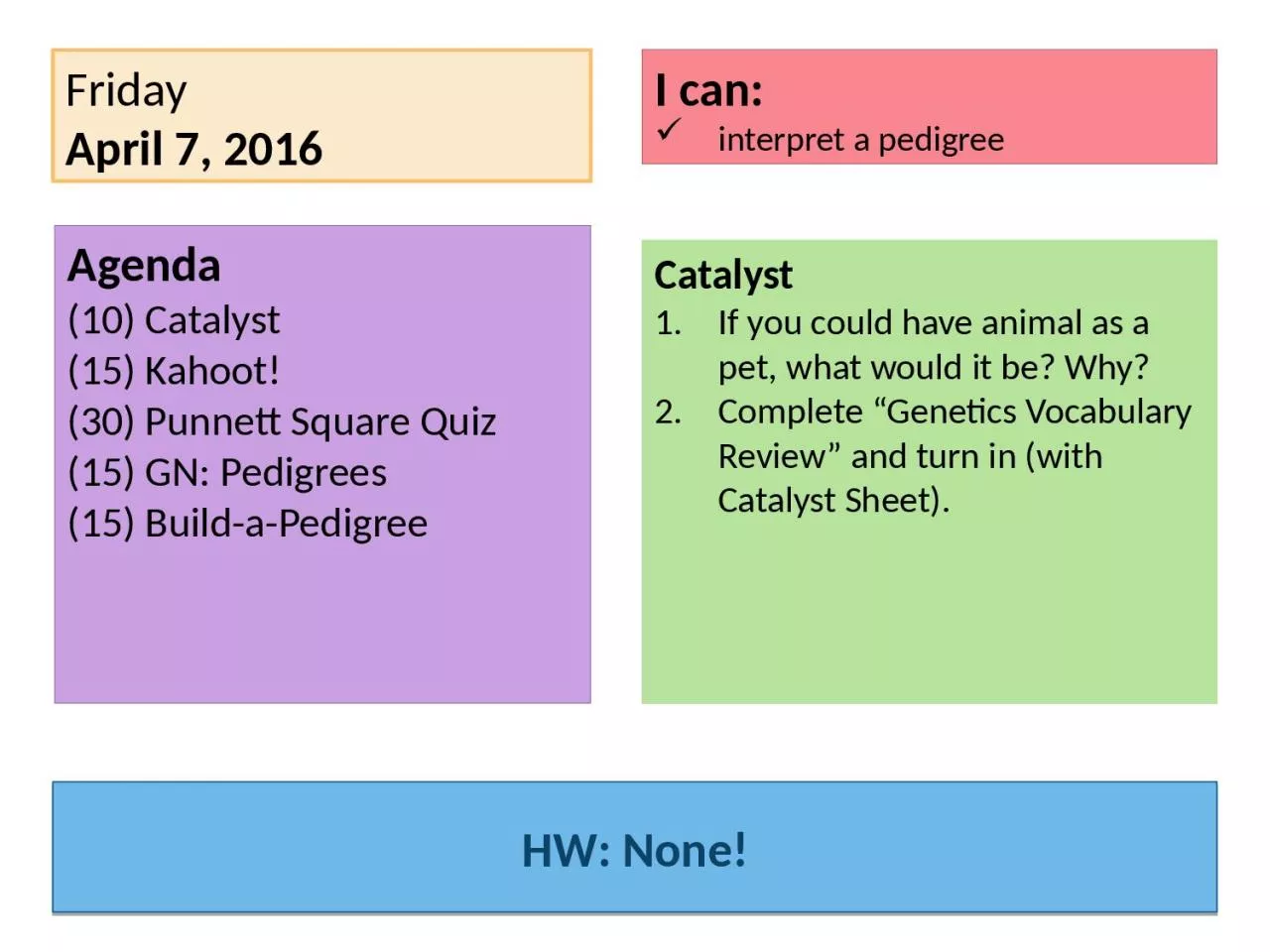

10 Catalyst 15 Kahoot 30 Punnett Square Quiz 15 GN Pedigrees 15 BuildaPedigree I can interpret a pedigree HW None Catalyst If you could have animal as a pet what would it be Why ID: 931966
Download Presentation The PPT/PDF document "Friday April 7 , 2016 Agenda" is the property of its rightful owner. Permission is granted to download and print the materials on this web site for personal, non-commercial use only, and to display it on your personal computer provided you do not modify the materials and that you retain all copyright notices contained in the materials. By downloading content from our website, you accept the terms of this agreement.
Slide1
FridayApril 7, 2016
Agenda(10) Catalyst(15) Kahoot!(30) Punnett Square Quiz(15) GN: Pedigrees(15) Build-a-Pedigree
I can:interpret a pedigree
HW: None!
Catalyst
If you could have animal as a pet, what would it be? Why?
Complete “Genetics Vocabulary Review” and turn in (with Catalyst Sheet).
Slide2Turned in STEM Survey(100% = party Thursday, 13th!)
Slide3Exit Ticket ReviewWhy are sex-linked traits more common in males than females? A. Males have two X chromosomes, and sex-linked recessive traits are expressed by inheriting only one recessive gene.
B. Females have two X chromosomes, and sex-linked recessive traits are expressed by inheriting only one recessive gene.C. Males have only one X chromosome, and sex-linked recessive traits are expressed by inheriting only one recessive gene.D. Females have only one X chromosome, and sex-linked recessive traits are expressed by inheriting only one recessive gene.
Slide4Exit Ticket Review2. Color blindness is inherited as a sex-linked trait in humans. Use a Punnett Square to complete a cross of a color-blind male with a female with normal vision who is a carrier of the trait.
Slide5Slide6red blood cells carry oxygen in the blood
Slide7normal red blood cells
sickle cell anemia
Slide8Slide9A pedigree is a visual representation of a family’s relatedness. It shows individuals who are affected by a certain trait.
Slide10We use symbols as a shorthand to represent individuals and their traits.
= male
= female
= affected individual
= carrier
A carrier
is a heterozygous individual unaffected by the trait.
*Not all pedigrees will use these symbols to show heterozygotes.*
Slide11We use symbols as a shorthand to represent individuals and their traits. = mating
= offspring in birth order
The generations are represented by Roman numerals. The individuals are numbered in normal numbers starting from the left.
I
II
I-1
I-2
II-
1
II-2
Slide12Draw the PedigreeJoe and Jackie have four children and are expecting a baby. Two of their children (Angie and Bob) have sickle cell anemia, and their other two children (Carl and Debbie) do not have the disorder. Neither Joe, nor Jackie, has sickle cell anemia. Joe’s parents, Jackie’s father, and Jackie’s sister also do not have the disorder. However, Joe’s brother has sickle cell anemia, and Jackie’s mother had the disorder and died as a young woman. Joe and Jackie ask you, a gene
counselor, how this disorder is inherited (dominant or recessive) and what the likelihood is that their unborn child will have sickle cell anemia.
Slide13Is sickle cell anemia found more often in certain ethnic groups?
Ashley-Koch A, Yang Q, Olney RS. (2000) Sickle Hemoglobin (HbS) Allele and Sickle Cell Disease: A HuGE Review. Am J Epidemiol Vol. 151, No. 9.
Slide14Malaria Incidence, 2009
Cibulskis RE, Aregawi M, Williams R, Otten M, Dye C (2011)
Worldwide Incidence of Malaria in 2009: Estimates, Time Trends, and a Critique of Methods. PLoS Med 8(12): e1001142. doi:10.1371/journal.pmed.1001142